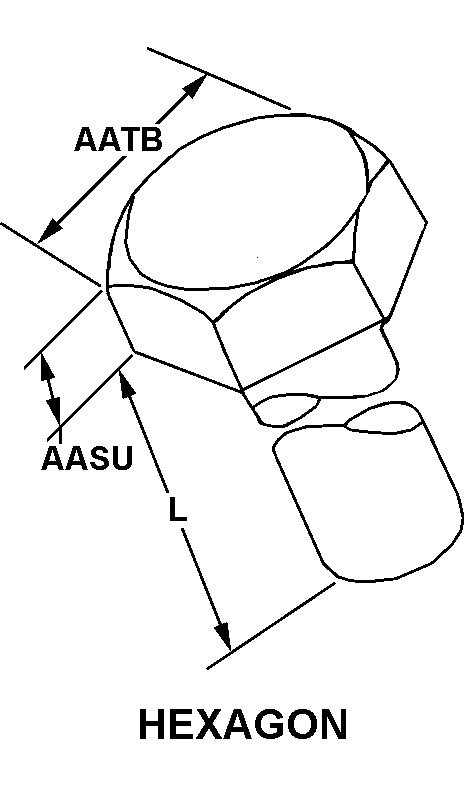5306006393003
Price Quote Get an up to date pricing and availability quote for this product. Order online or over the phone.
Quality Commitment
Serving our customers with quality and safety first.
- AS9120 Certified
- Audited supply chain
- ITAR Registered
- DDTC Registered
- HAZMAT Certified
- Customer service objectives
- Every product 100% inspected

5306-00-639-3003 Specification Set by the OEM (see RNCC code 3)
3a
RIGHT-Hand
1.485in. ⁓1-1/2"
3.562in. ⁓3-9/16"
hexagon
0.750in. ⁓3/4"
2.000in.
1.250in. ⁓1-1/4"
12
rlarge dia shoulder undercut at head to 1.500 dia. with 0.062 in. radius and small dia. shoulder undercut at large dia. shoulder to 1/375 in. dia. with 0.062 in. radius, with thread releif 1.094 in. and 0.062 in. radius
steel comp 4130
MPR-1, fscm 80020 mfr ref single material response
unf
Cross Reference Parts Part numbers that meet the specification outlined on this page and set by the OEM
Identification Item Identification Guide (IIG) and Item Name Code (INC)

Definition Definition of approved item name (AIN): "BOLT,SHOULDER"
An externally threaded fastener whose threaded portion is of one nominal diameter, no. 10 (0.190 in.) (5 mm) or larger. It has a round unthreaded neck or shank all or part of which is of greater diameter than the threaded portion. The head is not designed to be held or driven with an inserted drivers. A locking feature may be incorporated in the design of the head or threads. For items with a thread diameter smaller than no. 10 (0.190 in.) (5 mm) and those items with an inserted drive head, use screw, shoulder. For items which are no. 10 (0.190 in.) (5 mm) or larger in size and are both shouldered and have an externally relieved body, use bolt, externally relieved body. Excludes thumbscrew.
5306-00-639-3003 Material Hazmat, Precious Metals, Criticality, Enviroment, and ESD
Indicates there is no data in the hmirs and the nsn is in a fsc not generally suspected of containing hazardous materials.
Item does not contain precious metal.
Represents items with no adp components
The item does not have a nuclear hardened feature or any other critical feature such as tolerance, fit restriction or application.
Identification Codes
HMIC: Hazardous Material Indicator Code. A one position code that identifies a hazardous item.
PMIC: Precious Metal Indicator Code. A one position code which identifies items that have precious metals as part of their content. precious metals are those metals generally considered to be uncommon, highly valuable, and relatively superior in certain properties such as resistance to corrosion and electrical conductivity.
ESD: Electrostatic Discharge. Indicates if an item is susceptible to electrostatic discharge or electromagnetic interference damage. electrostatic discharge damage occurs when an accumulation of static electricity generated by the relative motion or separation of materials is released to another item by direct contact. electromagnetic interference damage occurs when an item comes into proximity with an electrostatic or magnetic field.
ENAC: Enviromental Attribute Code. Identifies items with environmentally preferred characteristics.
CRITL: Criticality Indicator Code. Indicates an item is technically critical by tolerance, fit, application, nuclear hardness properties, or other characteristics.
Material Management Material categorization and source of supply
Defense logistics agency, enterprise business systems
Material Codes
SOS: Source of Supply. A three position code or routing identifier code (ric), which identifies the source of supply activity.
SMIC: Special Material Indicator Code. A two position code, which categorizes material on the basis of requirements for source or quality control, technical design or configuration control, procurement, stocking and issue control, special receipt, inspection, testing, storage, or handling.
MMAC: Material Management Aggregation Code. A two position code that identifies an item of supply to be managed by a specific activity manager.
MCC: Material Echelon Code. A two position code employed by the marine corps in classifying items into categories by materiel category and procurement echelon. the alphanumeric management code is in the first position and identifies the materiel category
IMC: Denotes wether items shall be subjected to integrated management under the defense supply agency or retained by the individual military service or other department of defense components for their management. Assigned by th activity responsible for item management coding.






